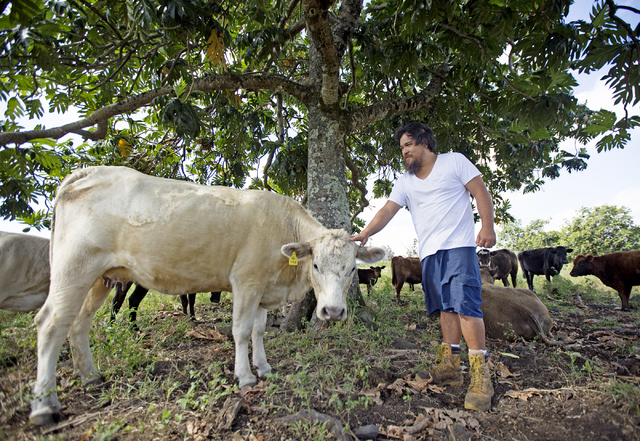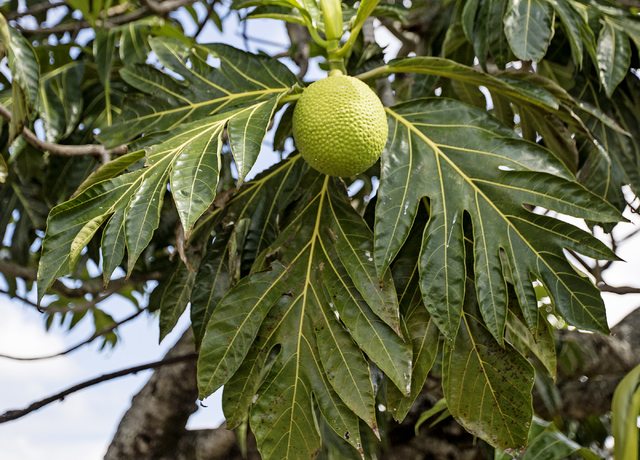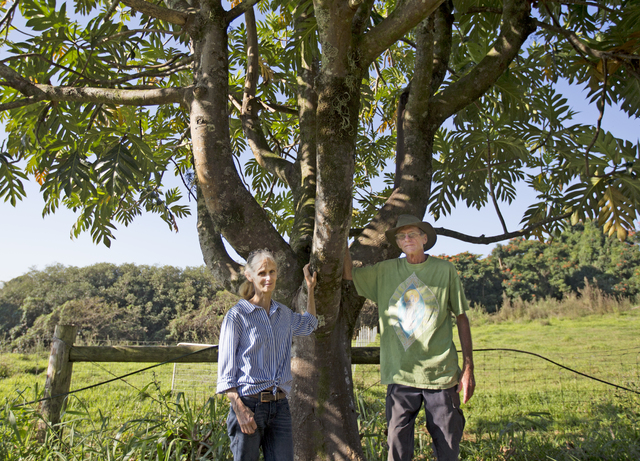The upside of ulu: Breadfruit growers working to maximize full potential of staple crop
It was hot with the faintest hint of breeze as Ethan Doctor drove a pickup truck down a bumpy road on his family’s 215-acre ranch in Kalapana. In one of the paddocks, a few dozen cows rested in the shade of a tall Hawaiian ulu (breadfruit) tree. Calves no more than 2 months old stood by their mothers. A bull with curving horns stared at a group of visitors as their feet crunched over broken lava rock.
ADVERTISING
One cow munched on a broad ulu leaf.
Doctor is the fifth generation of his family to work the land, which was hand-cleared more than a century ago. Some of the ulu trees on the ranch are about as old: their trunks are 2 feet across and their canopies of yellow-green leaves stretch high above the sloping land.
Cattle are the focus of ranch operations, and the ulu trees have saved the herd on more than one occasion. During drought, the trees drop their fruit and leaves in an effort to conserve energy. The fallen bounty in turn kept the cows alive (in Hawaiian mythology, Ku buried himself in the ground during a famine to save his family, emerging as an ulu tree).
Ulu is a powerhouse fruit, a staple crop that grows on trees, not in the ground like fellow starches wheat and corn. It’s protein-rich and thrives just about anywhere in the tropics. A canoe plant, it was brought to Hawaii by early Polynesians.
Today on Hawaii Island, ulu is cultivated from Kalapana to Kona and along the Hamakua Coast. Hawaiian ulu isn’t the only variety found here; a Samoan type called ma‘afala also is common.
Doctor and his wife, Ashley, are part of the Hawaii Ulu Producers’ Cooperative, a group formed last July with the goal of getting more ulu out into the community and ultimately helping address one of the most pressing issues about island life.
“Down the road, I think we really just want to help push the industry and the market forward in order to significantly improve Hawaii’s food security,” said co-op manager Dana Shapiro. “Ulu has that potential more than any other crop.”
“It can replace wheat and rice and potatoes, which are all imported,” she said. “It can really make a difference long term.”
A Senate bill introduced in this year’s legislative session would provide funding for ulu research and cultivation, noting that ulu has reached a point where it could be a “major commercial crop, even while remaining closely connected to traditional Hawaiian, Polynesian, Micronesian and Melanesian values.”
Still, ulu has yet to fully live up to its potential, something the co-op is working in overdrive to change. By combining and coordinating resources, members are able to address one of the biggest challenges to creating an ulu market.
“I think that the biggest barrier to ulu is really its seasonality,” En Young, director of The Food Basket, Hawaii Island’s food bank, said in an email.
“You get a ton of fruit for a month, and then you get no fruit for six months,” Shapiro said.
“You figure one tree in full production is 1,000 pounds to 2,000 pounds … and I have 100 trees,” Doctor said. “So, really, I didn’t know what to do with them.”
When he was younger, Doctor’s family sold the breadfruit to a Hilo bakery to be turned into, well, bread. But after awhile, harvests stopped, leaving the fruit for the cows, who enjoyed the meals but still couldn’t keep up with all of the ulu.
“When they produce, you get this cornucopia of fruit that you have to use right away,” said Jackie Prell, owner of Sweet Cane Cafe in Hilo. The cafe offers a number of ulu items, from ulu chocolate mousse to jalapeno ulu burgers. Prell and her husband, John Caverly, have about 40 trees on their Pepeekeo farm.
“The trick of eating ulu is to pick it right,” Caverly said. Fruit should be picked when its white sap begins to leak out.
In the past six months, the group has processed and sold more than 12,000 pounds of ulu. Most is processed at Sweet Cane Cafe, and stored in freezer space donated by The Food Basket.
The Food Basket on occasion now includes ulu in its Community Supported Agriculture boxes.
The co-op sells ulu to natural food stores around the island, as well as restaurants and hotels such as Cafe Pesto in Hilo, Pau and Village Burger in Waimea, the Mauna Kea Beach Hotel, Four Seasons Hualalai and Waikoloa Beach Marriott.
“Restaurants want to make steady menus, and with a global supply chain we’re used to getting … staples year round,” Young said. Processing the ulu beforehand and storing it allows for more flexibility. “We’re making sure people can get ulu when they’re craving it, and not (having) to eat 50 pounds a week when their tree is loaded.”
“It really is such a wonderful staple,” Prell said.
Shapiro had never heard of ulu until 2011, when she was asked by a friend to help coordinate a breadfruit festival. She decided to enter a cooking contest at the event and quickly discovered how versatile the fruit was.
“You can eat it at any stage, and it’s completely different from one to the other,” Shapiro said. “When it’s a baby, before it even gets full-sized, you can steam it and marinate it, and it’s just like an artichoke heart.”
As the fruit matures, it becomes more starchy, like a potato.
“The most delicious sweet potato,” Shapiro said. “It has a really unique and complex sweet fruit flavor.”
In her culinary exploration of ulu (she won third place in the contest, and took first place the next year), Shapiro learned more about its cultural significance, in large part thanks to festival board member Noa Lincoln, a researcher at the University of Hawaii at Manoa who studies traditional Hawaiian farming systems. Lincoln’s doctoral work focused on the old South Kona ulu belt, a massive 20-mile stretch of breadfruit forest planted in Kamehameha I’s day. The belt produced between 50,000 and 60,000 tons of ulu annually.
Lincoln and Shapiro are now married (“We met through breadfruit,” Shapiro said), and working to restore that ulu belt. Their farm, Mala Kalu‘ulu, is a five-member co-op within the bigger ulu producers’ group.
Lincoln also works with Doctor on a research project to determine what kinds of ulu grow best in Kalapana. He’s thinking of planting ma‘afala on the ranch to complement the old Hawaiian trees.
It’s hard to imagine the ranch without ulu.
“I hear stories of people that were 90 (years old) come up here and picking fruit,” Doctor said.
“Going to the store was actually going to the ulu tree,” Caverly said.
Email Ivy Ashe at iashe@hawaiitribune-herald.com.





